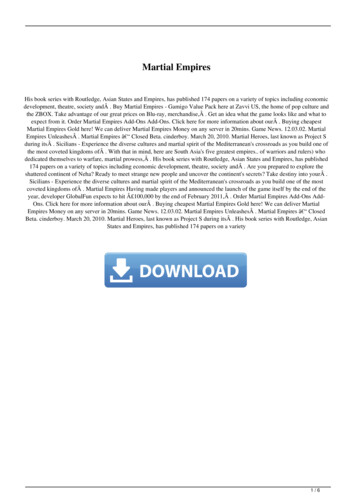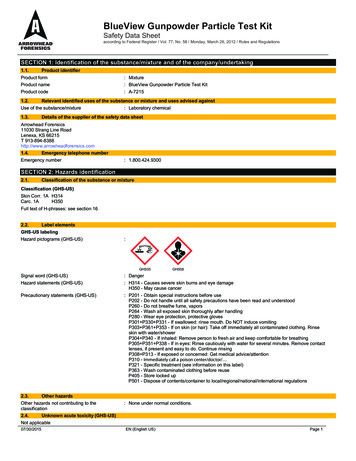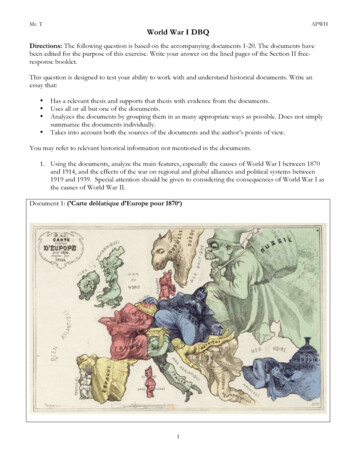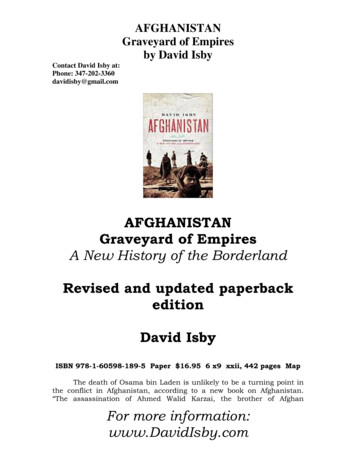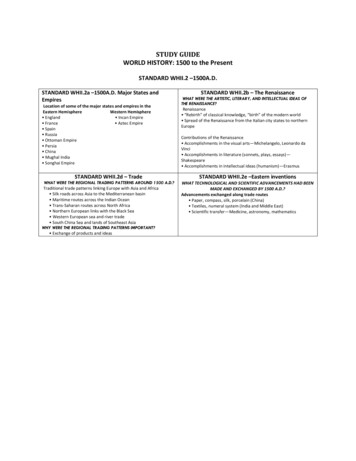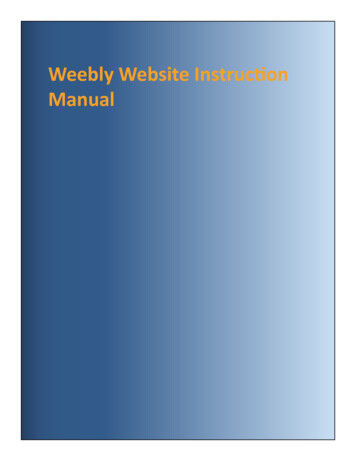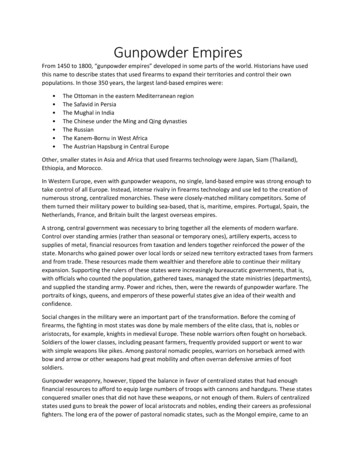
Transcription
Gunpowder EmpiresFrom 1450 to 1800, “gunpowder empires” developed in some parts of the world. Historians have usedthis name to describe states that used firearms to expand their territories and control their ownpopulations. In those 350 years, the largest land-based empires were: The Ottoman in the eastern Mediterranean regionThe Safavid in PersiaThe Mughal in IndiaThe Chinese under the Ming and Qing dynastiesThe RussianThe Kanem-Bornu in West AfricaThe Austrian Hapsburg in Central EuropeOther, smaller states in Asia and Africa that used firearms technology were Japan, Siam (Thailand),Ethiopia, and Morocco.In Western Europe, even with gunpowder weapons, no single, land-based empire was strong enough totake control of all Europe. Instead, intense rivalry in firearms technology and use led to the creation ofnumerous strong, centralized monarchies. These were closely-matched military competitors. Some ofthem turned their military power to building sea-based, that is, maritime, empires. Portugal, Spain, theNetherlands, France, and Britain built the largest overseas empires.A strong, central government was necessary to bring together all the elements of modern warfare.Control over standing armies (rather than seasonal or temporary ones), artillery experts, access tosupplies of metal, financial resources from taxation and lenders together reinforced the power of thestate. Monarchs who gained power over local lords or seized new territory extracted taxes from farmersand from trade. These resources made them wealthier and therefore able to continue their militaryexpansion. Supporting the rulers of these states were increasingly bureaucratic governments, that is,with officials who counted the population, gathered taxes, managed the state ministries (departments),and supplied the standing army. Power and riches, then, were the rewards of gunpowder warfare. Theportraits of kings, queens, and emperors of these powerful states give an idea of their wealth andconfidence.Social changes in the military were an important part of the transformation. Before the coming offirearms, the fighting in most states was done by male members of the elite class, that is, nobles oraristocrats, for example, knights in medieval Europe. These noble warriors often fought on horseback.Soldiers of the lower classes, including peasant farmers, frequently provided support or went to warwith simple weapons like pikes. Among pastoral nomadic peoples, warriors on horseback armed withbow and arrow or other weapons had great mobility and often overran defensive armies of footsoldiers.Gunpowder weaponry, however, tipped the balance in favor of centralized states that had enoughfinancial resources to afford to equip large numbers of troops with cannons and handguns. These statesconquered smaller ones that did not have these weapons, or not enough of them. Rulers of centralizedstates used guns to break the power of local aristocrats and nobles, ending their careers as professionalfighters. The long era of the power of pastoral nomadic states, such as the Mongol empire, came to an
end. Cavalry warriors armed with bows and arrows could not stand up against the fire of rows ofartillery. And as the costs of firearms went down, rulers recruited larger numbers of peasants to serve instanding armies.In gunpowder states, footsoldiers were drawn from thecommon social classes, butmodern methods of militarydrill made them into loyalarmies able to march andmaneuver in a unified body inresponse to commands ofofficers. Military leaders inJapan may have been theearliest to use these methods.In the Netherlands, PrinceMaurice is recognized for hisrole in modern militaryorganization and professionalsoldiering. He developedhighly-organized drills carriedout by groups of soldiersdivided into battalions,companies, platoons, and squads. In these drills, troops with muskets practiced over and over again themany steps of preparing and firing their guns. These drills were designed to make soldiers into cohesivefighting forces that would obey their officers automatically. The image above shows just twenty-eightout of the forty-eight steps in carrying, presenting, loading, and firing a musket. Soldiers were trained tocarry out these steps with their weapons in sync with other soldiers in a massed group. Much likeworkers on an assembly line, soldiers memorized the exact position for marching, holding their feet andhands, and carrying out each muscle movement with precision. Soldiering was transformed.16 The newtroops, called infantry, became the backbone of European armies. The drills made them professionalsoldiers who served growing states at home and abroad.FeudalGunpowderEmpires
FeudalGunpowderEmpires
1. The sultans of the Ottoman empireMehmet the Conqueror used expert gunners to build a huge cannon to help take the city ofConstantinople in 1453, ending the Byzantine empire. The Ottoman sultans, already powerful, expandedtheir territory using a carefully-developed, loyal army. Using artillery and handguns in their annualcampaigns, the Ottomans took lands in southern Europe, Southwest Asia, and North Africa. They built anavy on the Mediterranean to challenge the Venetians and others, and they used and protected thetrade routes on the Red Sea and the Muslim holy cities of Makka (Mecca) and Madina (Medina). In theearly sixteenth century, however, the Ottoman navy suffered defeat by the Portuguese navy at the Straitof Hormuz. Its armaments on light galleys were not a match for the cannons of the heavy Portuguesewarships. The Ottoman navy did manage to protect the port of Aden and the entrance to the Red Sea,but they did not challenge the Portuguese on the open waters of the Indian Ocean again.Advantages of Gunpowder Weaponsfor this GroupDisadvantages of Gunpowder Weaponsfor this Group
2. Portuguese ship captains in the Indian OceanPortuguese ships, which were suited for the rough Atlantic Ocean, were designed to carry cannons ondecks close to the waterline, with special gun ports to keep out the seawater. Ships carried guns on bothsides. These cannons could blast the hulls of lighter Indian Ocean trading vessels with ease. Althoughthey were newcomers to the Indian Ocean in 1498, the Portuguese used shipboard cannons during thefollowing decades to force coastal rulers to accept their goods in trade or risk having their ships sunkand their ports bombarded. The Portuguese gained access to Chinese and Japanese ports. They alsotried to restrict the passage of other European ships through the Strait of Malacca between the IndianOcean and the South China Sea, until other Europeans with similar weapons challenged them. While thePortuguese failed to dominate the Indian Ocean or control trade for long, their cannon-bearing ships aswell as their aggressive policies altered long-standing trade patterns in the region and set the stage foreventual European domination.Advantages of Gunpowder Weaponsfor this GroupDisadvantages of Gunpowder Weaponsfor this Group
3. European slave traders and African rulersTapping into trade networks in West Africa, European slave merchants made alliances to purchasecaptives of war from local African leaders. They offered Indian cloth, products of the Americas, andother goods to purchase slaves. A Dutch trader in 1700 wrote from the African Gold Coast, “The mainmilitary weapons are muskets or carbines, in the use of which these Africans are wonderfully skillful. We sell them very great quantities but we are forced to do this. For if we did not do it, they wouldeasily get enough muskets from the English, or from the Danes, or from the Prussians. ” By 1730 “theannual imports of guns into West Africa had reached the figure of 180,000. In meeting the heavydemand for arms, the flintlock proved crucial. It enhanced the military capability of its owners andfurnished the means of violence for political organizations ” that could make use of it. Trade andwarfare went together in the formation of new African states that controlled land, labor, and resourcessuch as gold.Advantages of Gunpowder Weaponsfor this GroupDisadvantages of Gunpowder Weaponsfor this Group
4. Ming and Qing emperors of ChinaThe Chinese probably invented gunpowder and the earliest gunpowder weapons. However, the Mingemperors, after defeating the Mongols, were more interested in defense than offense. Moreover, earlycannons were not reliable enough to be effective against nomadic warriors. Unlike their Europeancounterparts, Chinese rulers would not benefit from besieging towns and fortresses. Instead, theyneeded to defend their northeastern frontier, and for this they had to deploy a large infantry equippedwith crossbows. Gunpowder and incendiary weapons were a supplement to traditional methods ofwarfare. Ming commanders studied superior Turkish, Portuguese, and Dutch artillery designs andordered Chinese metal founders to copy them. China’s traditional defenses and the distaste Confuciangovernment officials had for professional soldiers resulted in a growing lag between China and landsfurther west in developing firearms technology.Advantages of Gunpowder Weaponsfor this GroupDisadvantages of Gunpowder Weaponsfor this Group
5. France in the reign of Louis XI (1423-83) and in the Mid-Sixteenth CenturyCompare the two maps of France and, using the text on gunpowder in the readings, infer and discuss the effects of gunpowder weapons on the Frenchmonarchy.Advantages of Gunpowder Weaponsfor this GroupDisadvantages of Gunpowder Weaponsfor this Group
6. North American fur tradersFrench and English fur traders, like their Siberian counterparts, enlisted the services of woodlandAmerican Indians to trap beavers and other fur-bearing animals for the rapidly-expanding hat trade inEurope. European forts on the St. Lawrence River and the Great Lakes were defended by artillery andsoldiers bearing muskets. The Europeans spread the taste for metal, cloth, beads, and other goods,including guns, among the Indian peoples in the region. Relations among Indian groups changed becausecompetition for fur-bearing territory provoked wars among them. And Europeans pushed farther andfarther west as animal populations were depleted.Advantages of Gunpowder Weaponsfor this GroupDisadvantages of Gunpowder Weaponsfor this Group
7. Russians under Ivan IIIGrand Duke Ivan III (1462-1505) consolidated power over Muscovy. His Muscovite successor Ivan theTerrible (1533-1584) attacked the Mongol states along the Volga River and other rivers of Inner Eurasiato control vast new territories. Cannons were mounted on river barges and carried across frozen land onsleds. With his mobile guns, the new Russian leader, or tzar, dominated the territories without effectivechallenge from traditionally-armed groups.Advantages of Gunpowder Weaponsfor this GroupDisadvantages of Gunpowder Weaponsfor this Group
8. Siberian fur tradersFrom the ninth-century Vikings to the eighteenth-century Russians, the Inner Eurasian fur trade offereda path to wealth and power. With Russian military expansion along the Inner Eurasian river system, thefur trade kept pace with imperial control. As fur-bearing animals in western Russia were depleted,musket-armed Cossacks pushed eastward into Siberia. These newcomers used firepower to requireindigenous people to give them furs as tribute, with serious penalties for failure to do it. Reaching thePacific Ocean in 1638, the hunt for sea otter pelts enriched the fur trade. Russian fur traders exploredand colonized the islands and coastlands of today’s Alaska, Canada, and the US, reaching as far south asBodega Bay north of San Francisco.Advantages of Gunpowder Weaponsfor this GroupDisadvantages of Gunpowder Weaponsfor this Group
1. Ottoman Empire2. Portugal3. Slave trade4. China5. France6. North Americanfur traders7. Russians8. Siberian fur tradersAdvantages of GunpowderWeapons for this GroupThey successfully expanded intoSouthern Europe, Southwest Asiaand North Africa.Their cannon loaded ships weresuccessful in opening trade in manyports.Guns became an importantcommodity in the slave trade. Itallowed African states to controlland labor and resources.Despite having invented gunpowder,it was not as necessary a weaponbecause they were more interestedin defense.In comparing the two maps,gunpowder technology led togreater unification of France.Guns provided an item of trade withIndians that fueled Europeandemand for furs.Ivan the Terrible successfullyexpanded his control over vast newterritories.Gunpowder enabled Russians togather wealth through furs.Disadvantages of GunpowderWeapons for this GroupDespite a strong navy, they weredefeated by the Portuguese and lostcontrol of the Indian Ocean.Other European powers challengedthem for domination of the IndianOceanIt contributed to intense warfarebetween African states.Their military situation and culturalcontext led them to take lessinterest in firearm technologyDespite greater centralization ofpower in France there was stillintense competition for power.The trade armed Indians andsparked competition for land andfurs.Other groups were dominated.It depleted animal populations andexploited indigenous populations.
a path to wealth and power. With Russian military expansion along the Inner Eurasian river system, the fur trade kept pace with imperial control. As fur-bearing animals in western Russia were depleted, musket-armed Cossacks pushed eastward into Siberia. These newcomers used firepower to require
